 Anyone in Minnesota or Wisconsin have purple martin houses? Are they ready? Today I say my first of the year purple martins in Grantsburg, WI (near the Minnesota border). You usually see the bird martins arrive around tax day (April 15) in my neck of the woods, so these large dark swallows are right on time.
Anyone in Minnesota or Wisconsin have purple martin houses? Are they ready? Today I say my first of the year purple martins in Grantsburg, WI (near the Minnesota border). You usually see the bird martins arrive around tax day (April 15) in my neck of the woods, so these large dark swallows are right on time.
Brown Bird Migration
A quick public service announcement to those in Minnesota: you might want to put your hummingbird feeders out. This hummer migration map shows their arrival is eminent (to Mom in Indiana, your feeder should already be out).
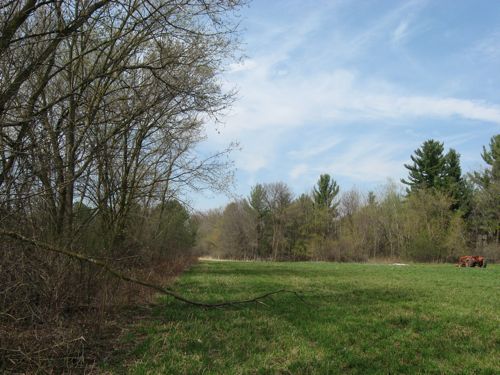
We ended up spending another night at Mr. Neil's and leaving for home this morning. I did not want to leave, migration is hot and heavy--I barely paid attention to the bees yesterday. As I was packing my birding gear back in the car, I heard a newly arrived brown thrasher. I was about to unload it for a quick video when rain began to pour as if someone turned on a faucet. We had to leave to get Non Birding Bill into town to get to work on time and I momentarily wondered if he wished the rain into existence to keep me on schedule.
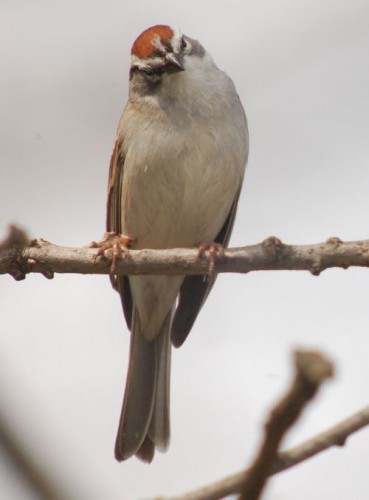
Chipping sparrows were the most vocal arrival. There loud extended trill was all over the yard--such a clear sign of spring. I have to say that I am totally digging eBird's BirdsEye app for the iPhone and iTouch for migration. I did a quick check to see what birds had already been reported in and around the area with it before we headed out to Mr. Neil's and had an idea of what to expect around our bee yard. I also could see what had not been reported yet and give myself a little goal of trying to find it.
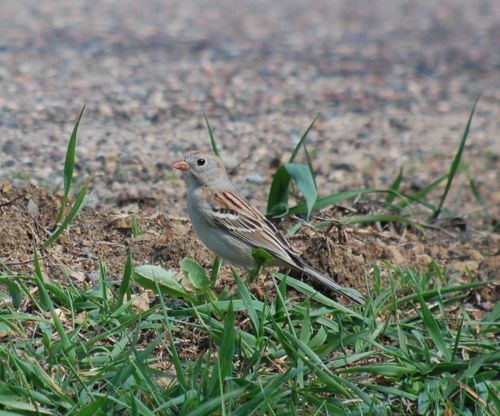
Every bird needed to be checked when I was out yesterday. What at first appeared to be a flock of chipping sparrows would have unexpected jems like this little field sparrow. I was hoping to hear it sing, but it was focused on foraging and loading up for a flight further northward. As I worked the sparrows, I heard a familiar call. I scanned the nearby field and found:
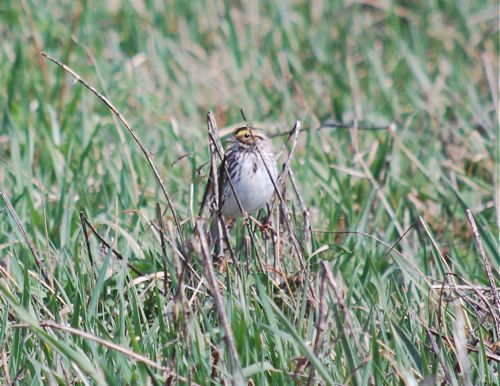
It was the soft song of the Savannah sparrow, there were at least three of them in the field. I tried to convince myself that I had never heard them this early but after a check of the Minnesota Ornithologists' Union migration arrival dates, this bird is right on time. Perhaps I don't recall April including 74 degree days.
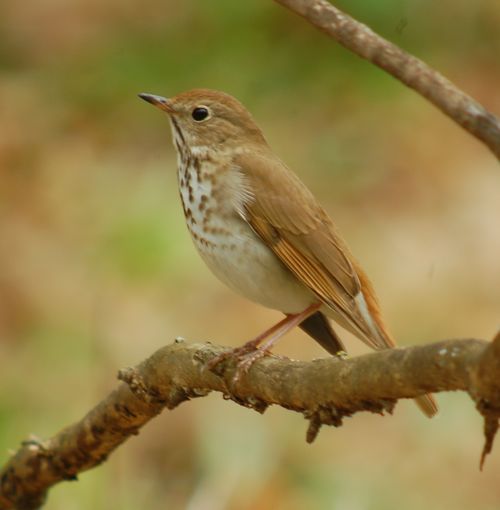
Someone emailed recently asking where the hermit thrushes are. I check the BirdsEye app and that was one of the birds that's been reported so I kept an eye out for them. Sure enough, down by the creek was a small flock quietly foraging on the ground. That's a bird I wish I could have heard, they have a gorgeous song but I guess I will have to wait a few weeks more. Ah well, at least I have them as one of my ring tones on my Blackberry Manilow.
I didn't want to come back to the Cities this morning but I have lots of work to get through and I'll have more chances to see birds this weekend. If you like, you can join me Saturday at Coon Rapids Dam at 9am for a digiscoping workshop and bird walk and there will be great birds along the Mississippi River to see.
Also, this Sunday is the Birds and Beers Woodcock Edition gathering. Hope you can make it for some birding and birder camaraderie. We're gonna lek out with a our woodcocks out!
Odd Broad-winged Hawk & Odd Warbler
Migration was in full spring today. It was a brown bird explosion which makes me so happy--new sparrows everywhere and this morning I was especially pleased to notice a small but steady stream of broad-winged hawks over our bee yard. I noticed the birds were fairly low and trying to get into thermals. I saw them close to the 10 am mark which made me wonder if this was a small flock that roosted nearby for the night and if this was a morning lift off?
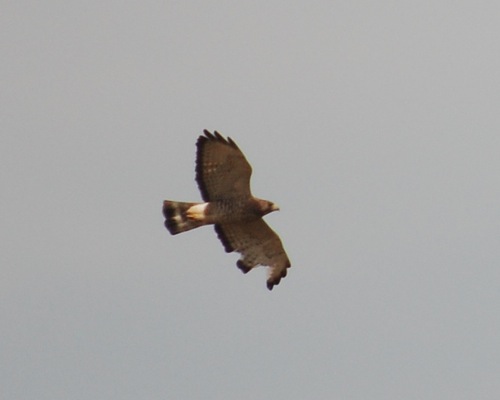
One broad-winged hawk really stood out. Check out that right wing--it's almost as if something took a bite out of it. It's missing a chunk of primary and secondary wing feathers. I don't think this is a molting issue but not sure how it happend--altercation with a larger aerial predator? Attack from some South American predator over the winter? That's a significant chunk to lose on one wing and it must affect the bird's ability to soar and dive after prey.
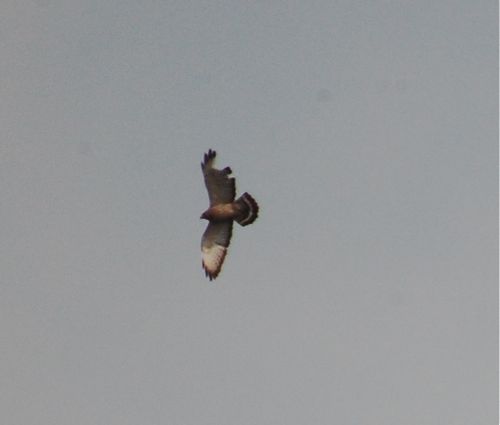
As I was digiscoping this bird, I thought about how migration is hard enough, but to do it with a chunk of flight feathers missing must be a real bummer. However, the bird has made it this far, perhaps it is only going to the northern part of the state--they do breed here and it's journey may be almost over. As always, this is a testament to a wild bird's ability to survive in nature no matter what. Kind of puts those bad hair days into perspective.
In other interesting bird news Ryan Terrill posted a link to some photos on ID Frontiers of what appears to be a bilateral gynandromorphic black-throated blue warbler (ie: it looks male one on side, female on the other). As if warblers weren't hard enough--sheesh! The bird was banded recently in Jamaica. To make this even more interesting, last fall birdspot posted photos on Twitpic that she took in Central Park, NY of what appears to be a first year gynandromophic black-throated blue warbler seen here and here...is this the same bird? In both Ryan's photos and birdspot's photos the male and female parts seem to be on the same bird...
We have absolutely no way of knowing since it wasn't banded last fall, but it does bring up one intriguing possibility that it could be the same bird. Gynandromophia is unusual but so is refinding the same bird in a different country on migration.
Coming Workshops
 This Sunday, I’ll appear in a National Park Ranger capacity at Freedom Park in Prescott, WI. This will be a slide show of birds along the upper Mississippi Flyway like the above hooded merganser and along the park’s borders, the Mississippi National River and Recreation Area. I’ll share photos I’ve taken of some of these great birds, tell some stories about finding them and give tips on the best places to visit. Freedom Park has a fantastic view of the river and it’s great for waterfowl and eagle watching–I’ve even watched coyotes hunting along the banks. This is a fun place to spend an early spring afternoon (and don’t forget to allow time for some of the tasty restaurants in downtown Prescott).
This Sunday, I’ll appear in a National Park Ranger capacity at Freedom Park in Prescott, WI. This will be a slide show of birds along the upper Mississippi Flyway like the above hooded merganser and along the park’s borders, the Mississippi National River and Recreation Area. I’ll share photos I’ve taken of some of these great birds, tell some stories about finding them and give tips on the best places to visit. Freedom Park has a fantastic view of the river and it’s great for waterfowl and eagle watching–I’ve even watched coyotes hunting along the banks. This is a fun place to spend an early spring afternoon (and don’t forget to allow time for some of the tasty restaurants in downtown Prescott).

I also got booked last minute for the Hawk Migration Association of North America Conference in Duluth, MN on April 16. It will be a digiscoping workshop (using a point and shoot digital camera or digital slr camera with your spotting scope to take photos. I think afterwards we can walk to one of the nearby peregrine falcon nest boxes and practice taking photos.
For anyone attending either workshop--feel free to bring your digiscoping equipment, especially if you have trouble getting photos with your set up. If you are not sure if you can digiscope and you only have the camera or only have the scope, bring them along and we can discuss options for you.
Peregrine Falcons At The Colonnade
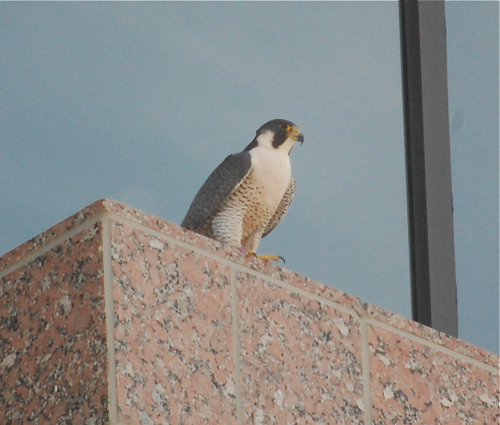 I was out at the Colonnade to check out the peregrine falcons that nest on that building. I had a KARE 11 segment this week and when I drove by the tall building, I could make one of the birds perched on the nest box ledge. When I returned with my digiscoping equipment that male visible. This is a nesting territory that I've blogged about before and some very interesting prey items have been found in their nest box.
I was out at the Colonnade to check out the peregrine falcons that nest on that building. I had a KARE 11 segment this week and when I drove by the tall building, I could make one of the birds perched on the nest box ledge. When I returned with my digiscoping equipment that male visible. This is a nesting territory that I've blogged about before and some very interesting prey items have been found in their nest box.
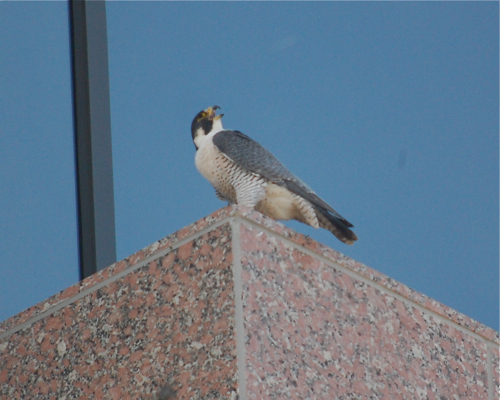
As I watched him for a bit, I wondered if he had a female laying eggs or incubating. Then he kept looking up and soon began to vocalize. When I volunteered at The Raptor Center and we would be outdoors with the education birds, we learned that if they looked up, you should look up, they saw an aerial raptor--sometimes it would be a mere pepper speck to me. I tried to follow the male's gaze skyward but could not see any other raptors flying over.
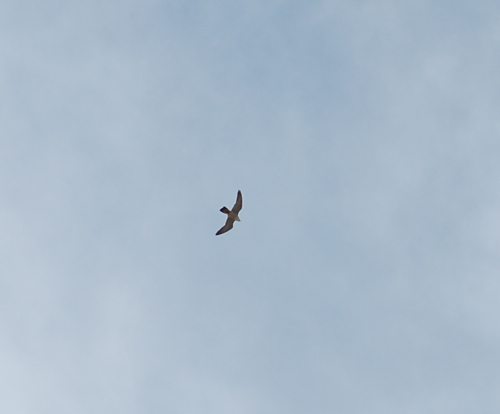
Then I saw her. A big female circling...and then I saw a second one (who was too fast for a photo). An aerial battle between two females was underway. Look at those distinct pointed wing tips that separates a falcon from a red-tailed hawk! In raptors, females are larger than the males (especially with peregrine falcons) and the females will engage in bloody battles to the death for prime territory. There's an infamous story from the Colonnade in the 1990s of 2 females who battle for over 2 and a half hours for the nest box--one losing an eye and eventually her life. Excited at my discovery of an aerial battle, I texted my buddy Mark Martell who has been involved with banding the birds at this building. He immediately replied, "I can just see you out there shouting, 'Chick fight!'"
He wasn't too far off in his guess. The best part of it was as the females circled the building and chased each other, the male remained at his perch screaming...perhaps he too was calling, "Chick fight...over MEEEEEEEEEEE!"

Actually, he did something kind of interesting. As the females duked it out in the air, he hunched over, fluffed his feathers and appeared to flash his cloaca. I wondered if this was some sort of display of encouragement to his mate or he was just flashing the goods to the females, "Yes, ladies, this is what I have to offer the winner of this display!"
The battle was probably more about the territory than the male.
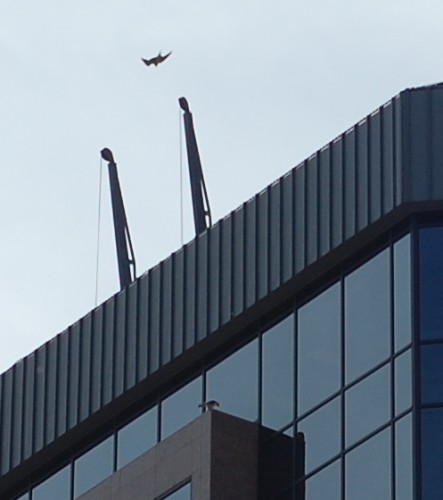
It wasn't a very serious battle and it soon ended. The other female was chased off and the remaining female circled the building and flew to the ledge where the next box it tucked away. Mark said that the people who monitor the falcons from inside the Colonnade report there is one egg in the nest.
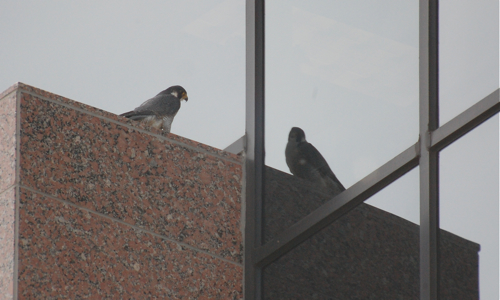
After all settled down, the male continued his watch of their skies from a nearby ledge. Then he walked towards his reflection on the windows. If one were to attribute human emotions to this bird, he could be thinking, "Yeah, boy, you are the total package. They wanted you, my man."
But who knows what drew this bird to the window.
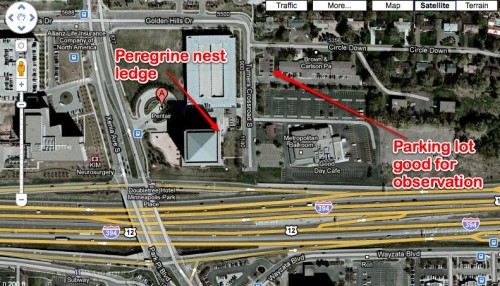
If you want to watch the peregrines at the Colonnade there is a small parking lot to the northeast of the building--just to the east of the parking garage for the Colonnade. You could also try driving to the top of the Colonnade's parking garage and watching from a scope there but I'm not sure how the building's security team feels about that. The Colonnade is on the northeast corner of hwy 394 and the Xenia Ave & Park Place exit on the west side of Minneapolis.

If you know what to look for, you can usually make out one of the adults perched on the ledges of the building. But to see the falcons well, you will need to have a scope or at the very least some binoculars to get a better look.
Random Song Sparrow
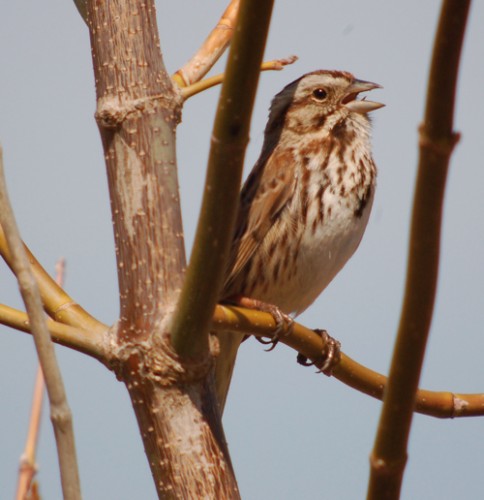 Holy cow I saw a lot of migrants back today! Some like the above song sparrow were singing right on the same spot they were singing the year before. Today was full of first of the year birds for me including pelicans, phoebes and tree swallows. I hope we don't five inches of snow in the next month that puts a hitch in their arrivals.
Holy cow I saw a lot of migrants back today! Some like the above song sparrow were singing right on the same spot they were singing the year before. Today was full of first of the year birds for me including pelicans, phoebes and tree swallows. I hope we don't five inches of snow in the next month that puts a hitch in their arrivals.
North Mississippi Park Heron Rookery

This is the week to check out the great blue heron rookery at North Mississippi Regional Park (or the one at Coon Rapids Dam too). I headed out to the North Mississippi rookery yesterday to take a look, right now the nests are very visible--even without binoculars.

You can get a great view of all sorts of behavior including nest building as the herons are coming in from migration. Some have been at this rookery for a few weeks already.

Quite a few of the herons were perched on or near a nest and not moving. I read on Cornell's Birds of North America Online that like many migratory bird species, males arrive to the nesting grounds first and establish who is taking what nest. From there, when not foraging for food, a male will spend all his time at the nest. Perhaps these were males waiting for a female to court or hoping to prevent other males from stealing sticks for their nests.

A few herons were already incubating eggs. These nests will either be way ahead of the game with chick rearing or have to start over in a few weeks. We are heading out of an unusual March--no snow in the Twin Cities at all. This is highly irregular, March is technically our snowiest month. It's not out of the realm of possibility for us to get snow in April. I'm loving the opportunity to bike on the trails a whole month early, but I'm not going to hold my breath and say that we are totally free of snow for the rest of the spring. If we get a cold snap, these already incubating herons may risk losing young and have to start over. But that's what birds do.

So, take a moment to head to one of our heron rookeries before the leaves are out. You can always somewhat see the nests at North Mississippi Regional Park and Coon Rapids Dam but it's ten times easier to point them to kids before the leaves are out. If this 70 degree weather keeps up, that could be rather soon...aw man, that means that leaves will be well out when warblers get here in May. That's going to make warbler watching a challenge.
UPDATE 2011: This heron rookery was destroyed by a tornado that ripped through Minneapolis in May, 2011. All the nests were destroyed. The birds did renest, some up river at Coon Rapids Dam and others at a new site at the Riverside Power Plant near the Head of Navigation on the Mississippi River. Most of the young did not survive, but the few that were rescued were eventually released later in the summer.
Spring Signs: Blackbirds & Merganser Style
 Friday, I had a meeting in Eden Prairie, MN--the southwest side of the metro Twin Cities. As I traveling on the highway, I noticed a large group of gulls loafing on a pond off the highway. I made a mental note of the exit and decided to stop there on my way back home after the meeting. When I pulled down the street, I noticed the ponds were almost completely ice free and could have some bird potential.
Friday, I had a meeting in Eden Prairie, MN--the southwest side of the metro Twin Cities. As I traveling on the highway, I noticed a large group of gulls loafing on a pond off the highway. I made a mental note of the exit and decided to stop there on my way back home after the meeting. When I pulled down the street, I noticed the ponds were almost completely ice free and could have some bird potential.

When I stepped out of my car, I could smell what had the gulls excited--a fish kill. The unmistakable aroma of dead fish hung in the air. The gulls were a mixture of ring-billed and herring and they were so chatty, you almost thought you were at a beach. A few crows joined the gulls in the rancid feast.

A couple of bald eagles made some passes over the gulls--spooking them a few times. The eagles flew low but did not land on the ice. I'm not sure if the eagles were uncertain about the quality of dead fish or the amount of people walking around the lake. The eagle pictured above eventually perched on top of a tree and watched the gulls for quite some time and never flew to the ice. I got the sense that the bird wanted its share of the dead fish but felt unsure of the situation.

I've heard red-winged blackbirds on and off the last week or two and their call was unmistakable around the fish kill lake. We still don't have any female red-wings here yet, so the early arriving males still have some time to negotiate their territories.

There was a pond on the other side of the parking lot that was completely ice free and I noticed some splashing sounds. A quick scan with the scope revealed about 3 pair of hooded mergansers engaging in some mating displays. Love these little ducks!

Hooded mergansers will use wood duck boxes for nesting--I had one use a nest box at the bird store a few years ago. It's cool to see this fish eating duck move further and further into the Twin Cities metro area for breeding purposes. Check out that male's bill above with that dainty little hook on the end of his beak. One of my favorite illustrations from the duck stamp contest I judged last week was of a male hooded merganser fishing underwater.

The males seemed to have each found a female and the settled down by the time I got close enough for some photos. I was hoping I could hear their mating call but I think even if they had been giving it, the close by highway would have made it hard to hear. You can listen to hooded merganser mating calls at Xeno Canto--I love that little croaky call. I checked over at Cornell's Birds of North America Online for what entails the mating ritual for hooded mergansers and it reads, "Males have elaborate courtship behaviors which include Crest-raising, Head-shaking, Head-throws with Turn-the-back-of-the-head, Head-pumping, Upward-stretch, Upward-stretch with Wing-flap, and ritualized Drinking."

Not unlike humans. BNA says that you can distinguish "ritualized drinking" from "normal drinking" in male hooded mergansers by the strongly depressed crest and almost vertical orientation of the bill. So, if you're at a bar and a guy is trying to impress you with his drinking ability--perhaps he is trying to woo you with a merganser flirting strategy? If you suspect that is the case and you would like to take him up on his advances, you can respond by moving your head up and down in a rapid, jerky motion with your bill (or chin) pointed downward, uttering a hoarse gack.
Here's a video that I got at Wood Lake a couple of years ago of a little hooded merganser display:
[youtube]http://www.youtube.com/watch?v=AeG5KKa539A&feature=player_embedded[/youtube]
Mississippi Flooding In St Paul, MN
 It's an oddly exciting day at the National Park I work for (Mississippi National River and Recreation Area)--the river is flooding and it's odd to be excited by the flood and watch what the water will do. Since our visitor center is based in the Science Museum lobbby, we're right on the Mississippi River in St. Paul, MN. We have an awesome view. That's a giant tree working it's way down towards Raspberry Island (which is mostly submerged at this point).
It's an oddly exciting day at the National Park I work for (Mississippi National River and Recreation Area)--the river is flooding and it's odd to be excited by the flood and watch what the water will do. Since our visitor center is based in the Science Museum lobbby, we're right on the Mississippi River in St. Paul, MN. We have an awesome view. That's a giant tree working it's way down towards Raspberry Island (which is mostly submerged at this point).
 St. Paul has closed Sheperd Rd. from behind the museum all the way to Hwy 61 in preparation for the flood. One of the officers I spoke with said parts were already under water. I spent a majority of Sunday afternoon roving and interpreting the flooding--what ranger wouldn't rather be outdoors on a sunny day? The river is in flood stage at 14 feet and when I was at the river it was at 16.4 feet. It's expected to crest on Wednesday at 19.5 feet!
St. Paul has closed Sheperd Rd. from behind the museum all the way to Hwy 61 in preparation for the flood. One of the officers I spoke with said parts were already under water. I spent a majority of Sunday afternoon roving and interpreting the flooding--what ranger wouldn't rather be outdoors on a sunny day? The river is in flood stage at 14 feet and when I was at the river it was at 16.4 feet. It's expected to crest on Wednesday at 19.5 feet!
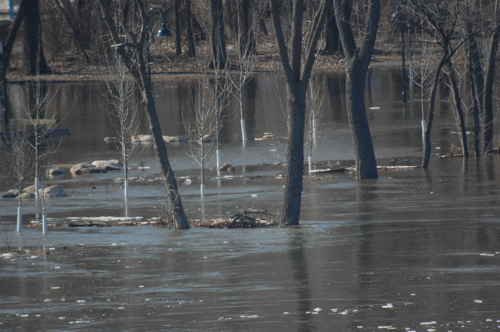
Across the way, Harriet Island was flooding. The police were trying to clear people off of it, but would have a better shot at herding cats. As soon as they would get one group to move on, 12 more people would walk in from the other side. Once church let out, the Harried flooded with people and the police seemed to give up. I have a feeling that tonight some serious barricades will go up and Harriet Island will be off limits for real tomorrow.
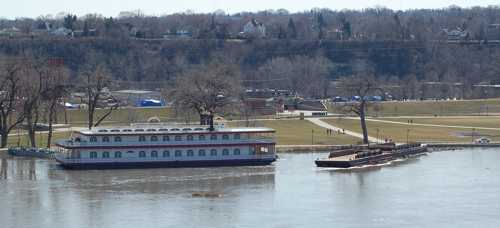
The Padleford boats are still docked at Harriet but barges have been placed in front of them to prevent debris from damaging them. If you watched the water up against the barges you could really get an idea of how strong the current was flowing. Here's a video I digiscoped:
[youtube]http://www.youtube.com/watch?v=LJ-E8oOzQOA[/youtube]
Did you hear the house finch singing on territory in the background? Here he is:
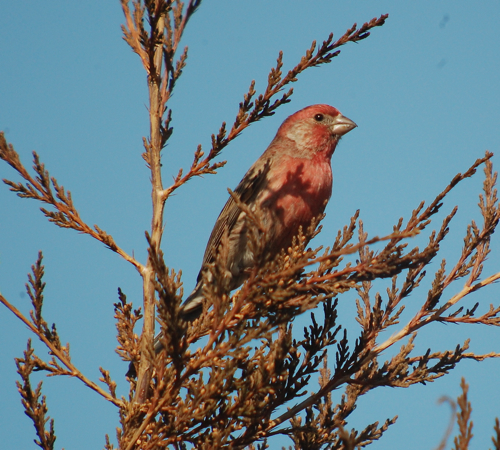
He was duking it out with another male for space in this tree outside the museum--prime real estate in downtown St. Paul and relatively safe from flooding...I wonder if the river will affect some of our early nesters like wood ducks, mallards and Canada geese?
If you want to watch some of the flooding, there's a great view from the Science Museum and be sure to visit us at the Mississippi River Visitor Center in the lobby. To watch the predictions for the crest, check out NOAA's website.
Spring In Sax Zim Bog
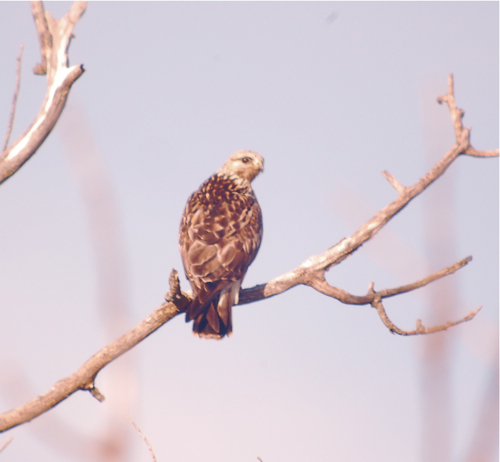 Boy! I needed yesterday. I got one last look at a rough-legged hawk before they head north to their breeding grounds.
Boy! I needed yesterday. I got one last look at a rough-legged hawk before they head north to their breeding grounds.
When Non Birding Bill opened his show MacBeth: The Video Game Remix, we engaged in the traditional opening night party after wards. When I woke up the following Monday morning, I wasn't sure if my body was having a bad reaction to my first long bike ride after winter, I was slightly hungover or coming down with a cold or flu. By the afternoon, it was obvious that I was getting sick. I hoped it would be mild, I had a busy weekend ahead with work and a friend from Michigan was coming to town and requested a Birds and Beers on Saturday night and a trip to Sax Zim Bog on Sunday. I sensibly spent the rest of the week sleeping, watching movies and eating lots of spicy food. Saturday I felt okay and had a terrific time at Merlin's Rest (so good that between it and Daylight Savings Time I managed only 3 hours sleep before leaving for the bog).
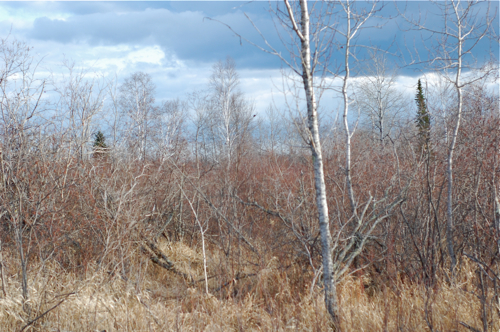
It was such a perfect day at the bog--mostly sunny, blue skies, a few colorful clouds, temperatures in the fifties and most of the snow melted. The sun brought out the color of the bark on the dogwood, grasses and pussy willow. I also had excellent company in the form of BlobbyBirdMan (aka Mark). I wondered if we'd see many sunny signs of spring and we did. Above you might notice a dark lump in a distant bare tree. That was Blobby's lifer porcupine.
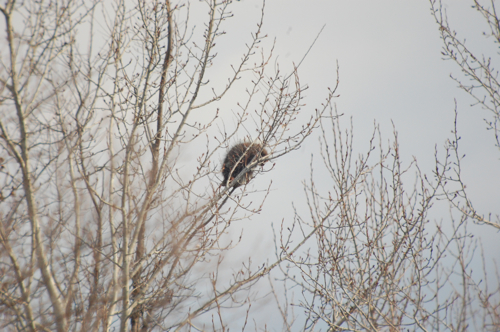
I tried to digiscope it as a souvenir for him but the porcupine appeared to be rather lethargic or doing his best impersonation of a sloth. We hoped we would hear ruffed grouse drumming and we did. It was distant, so we walked into the bog a bit, we found a log and sat for a long stretch to listen. About every ten minutes we would hear the tentative drum beating and then accelerate. I've always thought it more of a sound that you feel inside your rather than hear. Mark described it as more of a heart beat type sound. After being sick all week, I treasure the time spent on a log with no talking and natural sounds (periodically broken up by the sound of a distant train or surprisingly close ATV).
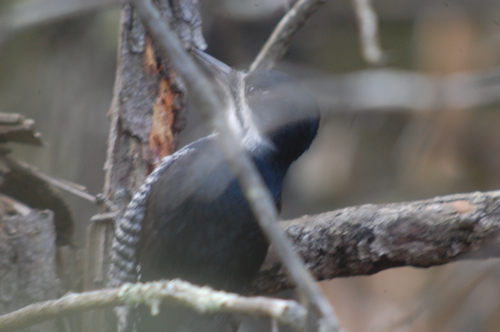
I did get off with a rather dubious start. The first bird I stopped our car for ended up being a starling. But not long after that, I stopped at a spot that looked good for black-backed and three-toed woodpeckers. As soon as I turned the engine off in my car, I heard soft tapping and it wasn't long before Mark got his lifer black-backed woodpecker. We also had a small flock of boreal chickadees show up too.
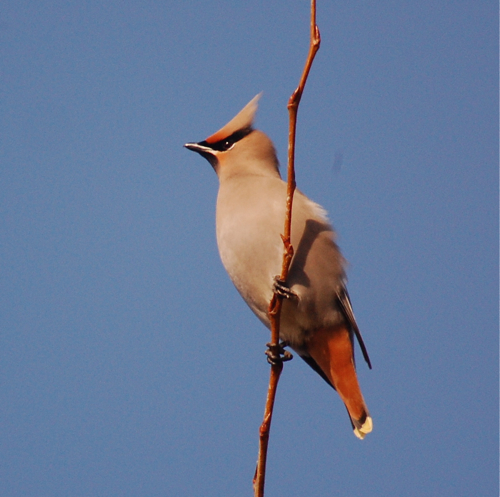
One of Mark's target birds was a bohemian waxwing and we saw several flocks. What was interesting was the very different attitude the birds had compared to last November when winter was just getting underway. Back then they were in large flocks and the birds stayed close together calling with a bit of urgency. The flocks we saw yesterday were very loose and calling but with an easy going frequency.
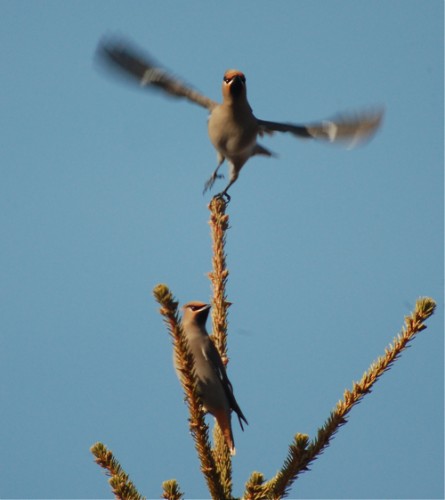
Some of them even appeared to be setting up pairs. The really exciting thing was the the waxwings weren't eating berries but jumping out into the blue and catching insects! It's warm enough for insects! Whoot! That was also confirmed on the drive home when several large bugs left tacky yellow smudges on my windshield.

There were still good numbers of pine siskins about but we didn't see much in the way of grosbeaks or redpolls. Some of the feeders were coming down in the bog too. The feeders on Blue Spruce road were missing. The home owners said that the pole came down during the melt and broke all the feeders. I asked if they needed some new ones. I figured birders would be willing to donate some since so many of us enjoy the feeders. They said that they get plenty of donations and that they would put them up again next fall.
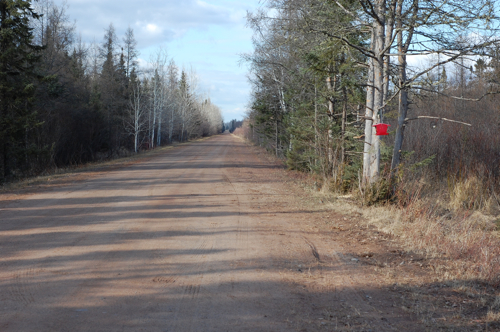
The feeders on Admiral Road were still going only now instead of a big old hunk of deer carcass, there's an actual bird feeder and suet cages. I heard that there had been some complaints from residents in the bog that the deer carcass would attract wolves. I think wolves are in the bog whether deer carcasses are hung or not--I actually saw one there a few years ago crossing the railroad tracks. But if the locals will allow feeders for public enjoyment as long as it's not a deer rib cage, that's a reasonable compromise. It's really nice that there are people willing to maintain public bird feeders in the bog. I know some mornings I don't always want to fill the feeder out the window.
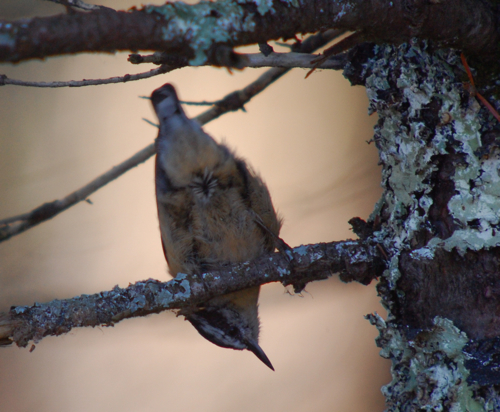
We saw mostly red-breasted nuthatches and black-capped chickadees at the feeder. Some blue jays and some grays also flew in. Red-breasted nuthatches were definitely pairing up. Look at the female red-breasted nuthatch above. By that swollen little cloaca, I'd say she's in them mood for some mating.
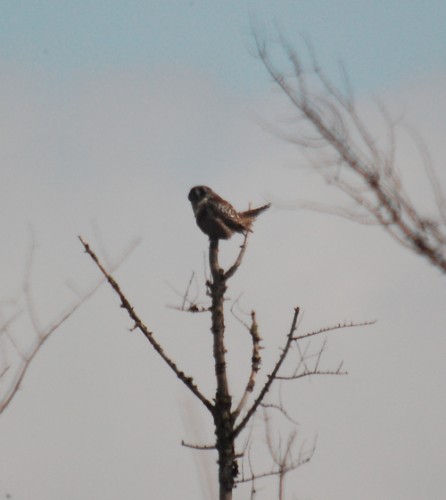
Speaking of mating, Mark spied a distant northern hawk owl and when we pulled over, we briefly saw a larger one beneath it mantling. The larger hawk owl dove lower into the trees and I wondered if we caught the tail end of a food pass between a male and female northern hawk owl? The smaller of the two continued his watch for prey from the tops of snags. We heard a bit of vocalization which is called the "scree yip" on the Cornell Owl CD. It can be used as either an alert to an intruder or during food pass. We were way too far out on the road to be causing it, so perhaps it was related to food passing. I hope they stay and raise a few chicks.
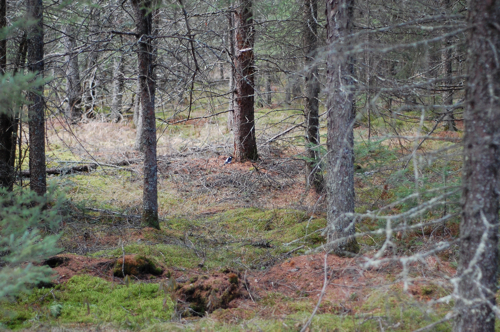
At another stop, we heard a woodpecker quietly working away at some bark and I hoped it would be a three-toed for Mark, I've seen them here before. Alas, it ended up being a hairy woodpecker, but I loved that it gave an excuse to sneak and see the green of the bog. When you look from the outside along the road, it looks like such a dark and foreboding place and inside the light filtered through the trees is a shady green.
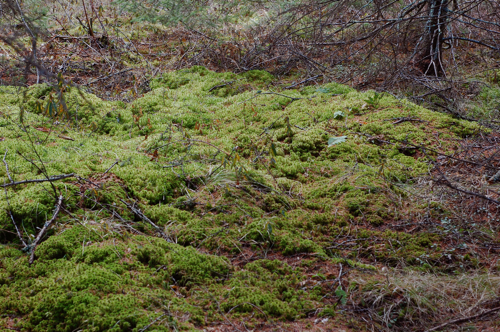
The spongy green floor looked to tempting. I wanted to take off my jacket and lay there for hours, feeling the cool of the green and enjoying the warm air. It almost seemed to say, "Sharon, winter is over for sure, spring and summer is definite in its arrival." But I'm not falling for that siren's song. It's too early in March for me to believe that we will have no more snow. I thought I would take an alternate route on the way home to try for a few species we missed. My navigational system and Google Maps took me to Great River Road. When we were about 6 miles from our destination, we saw an orange sign that read road work was ahead and there was suddenly no pavement. I went a few miles and felt the shifting mud from the melted snow get more unpredictable and said, "I'm not so confident about this road..."
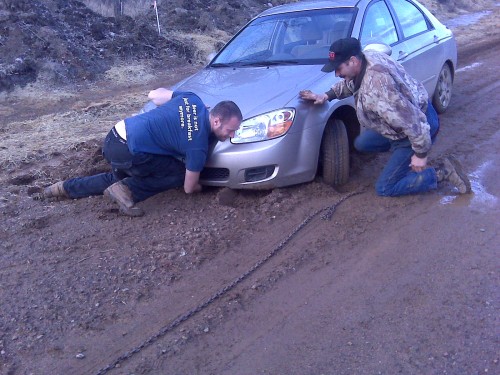
Famous last words! I swerved to the right side and was properly lodged into some mud. DOH! As I started to figure out how to explain my location to AAA, Mark walked to a neighbor who confirmed we were still on the Great River Road and that he's now so house bound, his neighbor down the way has to fetch his mail and drive him to town, his driveway is a mud trap. Mark thought it would be faster to look for this neighbor. We went about a quarter of a mile and their first sing of humans we passed was an old cemetery. I was beginning to worry this was going into urban legend territory and learn that this man hasn't had any neighbors for 30 years. Another half mile we found the neighbor who kindly offered to dislodge my Kia with his truck and gave us a route that would be on higher and drier ground. I owe him a big box of chocolates.
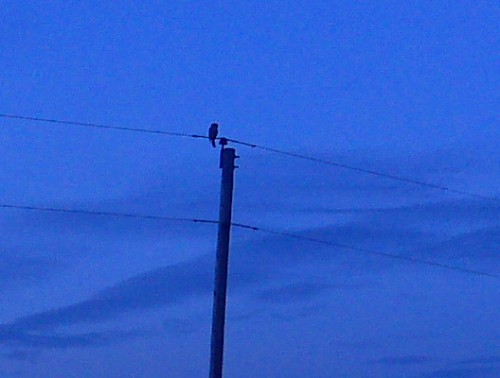
We made it out of the mud before sunset and on our way out we were rewarded with a very close northern hawk owl. It was too dark for digiscoping, but I got a quick photo with my blackberry. All and all it was a great adventure to cap off a week of being sick.
